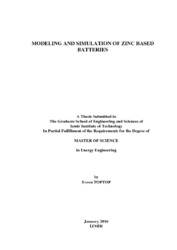Please use this identifier to cite or link to this item:
https://hdl.handle.net/11147/4548| Title: | Modelling and Simulation of Zinc Based Batteries | Other Titles: | Çinko Tabanlı Pillerin Modellenmesi ve Simülasyonu | Authors: | Toptop, Evren | Advisors: | Ebil, Özgenç Yüksel Özşen, Aslı |
Keywords: | Batteries | Publisher: | Izmir Institute of Technology | Source: | Toptop, E. (2016). Modelling and simulation of zinc based batteries. Unpublished master's thesis, İzmir Institute of Technology, İzmir, Turkey | Abstract: | Energy is the determining factor of productivity and quality of living. Electric energy is the most used energy form and lack of reserve for it hinders widespread use of renewable energy technologies. Advancements in renewable energy technologies, electric vehicles and consumer electronics are highly dependent on developments of new battery technologies. High energy density, long service life, using benign and abundant materials are few of the key requirements for next generation batteries. A model, a mathematical description of the system, is an effective tool to predict the behavior of batteries under specific conditions, thus reducing cost and time for the development. A mathematical model using finite element method was designed to simulate the discharge behavior of an experimental nickel-zinc battery that includes composite zinc and commercial nickel electrodes. The model employs thermodynamic and kinetic expressions for porous electrodes considering the concentration dependency of battery characteristics. The effects of initial zinc and nickel concentrations, anodic transfer coefficients of zinc and nickel electrode reactions on the electrochemical performance of the battery have been simulated. The discharge voltage, electrode porosities, and species concentrations in electrodes as a function of model parameters and time have been evaluated. It is observed that the model results are consistent with the experiment results considering that the battery operation is limited with zinc concentration. Initial zinc concentration is the major determining factor on discharge duration. Nickel oxyhydroxide concentration affects voltage magnitude. Transfer coefficients have only limited effects on discharge voltage and concentrations. Enerji, üretkenliğin ve yaşam kalitesinin belirleyici öğesidir. Elektrik enerjisi en çok kullanılan enerji çeşidi ancak yedeklenmemesi yenilenebilir enerji teknolojilerinin yaygın kullanımını önlüyor. Yenilenebilir enerji teknolojilerinde, elektrikli taşıtlarda ve tüketici elektroniğinde gelişmelerin gerçekleşmesi büyük ölçüde akü ve pil teknolojilerindeki ilerlemelere bağlı. Yüksek enerji yoğunluğu, uzun kullanım ömrü, zararsız ve bol bulunan malzemelerden imâlat yeni nesil pil ve aküler için çok önemli gereksinimler. Araştırmacılara belli koşullardaki akü ve pil davranışlarını tahmin etmelerini sağlayacak bir model, sistemin matematiksel bir tanımı, geliştirme sürecinin maliyetini ve süresini azaltacak etkili bir araç olacaktır. Bu çalışmada, ticari nikel elektrot ve kompozit çinko elektrot kullanılarak imâl edilmiş deneysel bir nikel-çinko pilin deşarj esnasındaki davranışı, sonlu eleman metodunu kullanan matematiksel bir model ile simüle edildi. Geliştirilen modelde gözenekli elektrotlar için geçerli olan termodinamik ve kinetik tanımları pil ve akü niteliklerinin konsantrasyon bağımlılıkları da göz önünde bulundurularak kullanıldı. Başlangıçtaki çinko ve nikel oksihidroksit konsantrasyonlarının ve çinko ve nikel elektrot reaksiyonları anodik transfer katsayılarının pilin elektrokimyasal performansına etkileri simüle edildi. Deşarj gerilimi, elektrot gözenekliliği ve elektrotlardaki malzeme türü konsantrasyonları, model parametrelerine ve zamana bağlı fonksiyonlar olarak hesaplandılar. Model sonuçlarının deneysel pille yapılan deney sonuçlarıyla, çinko konsantrasyonu sınırlı çalışması noktasında uyum gösterdiği gözlemlendi. Elde edilen simülasyon sonuçlarına göre başlangıçtaki çinko konsantrasyonu deşarj süresinde en belirleyici öğe. Başlangıçtaki nikel oksihidroksit konsantrasyonu ise deşarj geriliminin büyüklüğünde etkili. Transfer katsayılarının ise deşarj gerilimleri üstünde etkili olduğu, bununla birlikte konstrasyon değişimlerine etkilerinin çok sınırlı olduğu ve deşarj süresine hiç etkilerinin olmadığı görüldü. |
Description: | Thesis (Master)--Izmir Institute of Technology, Energy Engineering, Izmir, 2016 Includes bibliographical references (leaves: 99-102) Text in English; Abstract: Turkish and English xvii, 106 leaves |
URI: | http://hdl.handle.net/11147/4548 |
| Appears in Collections: | Master Degree / Yüksek Lisans Tezleri |
Files in This Item:
| File | Description | Size | Format | |
|---|---|---|---|---|
| T001411.pdf | MasterThesis | 3.6 MB | Adobe PDF |  View/Open |
CORE Recommender
Page view(s)
270
checked on Mar 31, 2025
Download(s)
930
checked on Mar 31, 2025
Google ScholarTM
Check
Items in GCRIS Repository are protected by copyright, with all rights reserved, unless otherwise indicated.